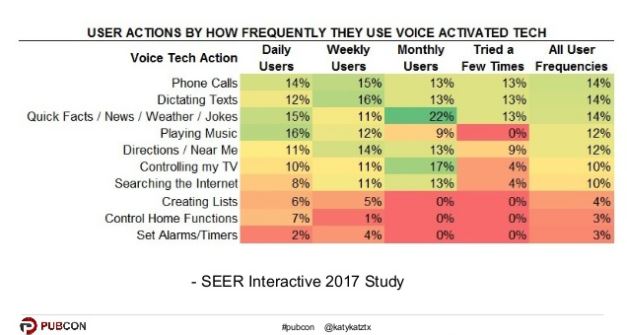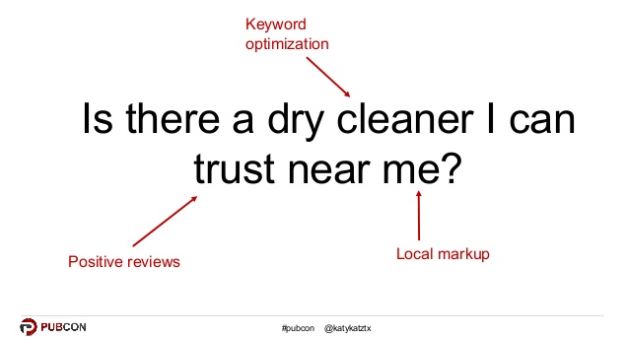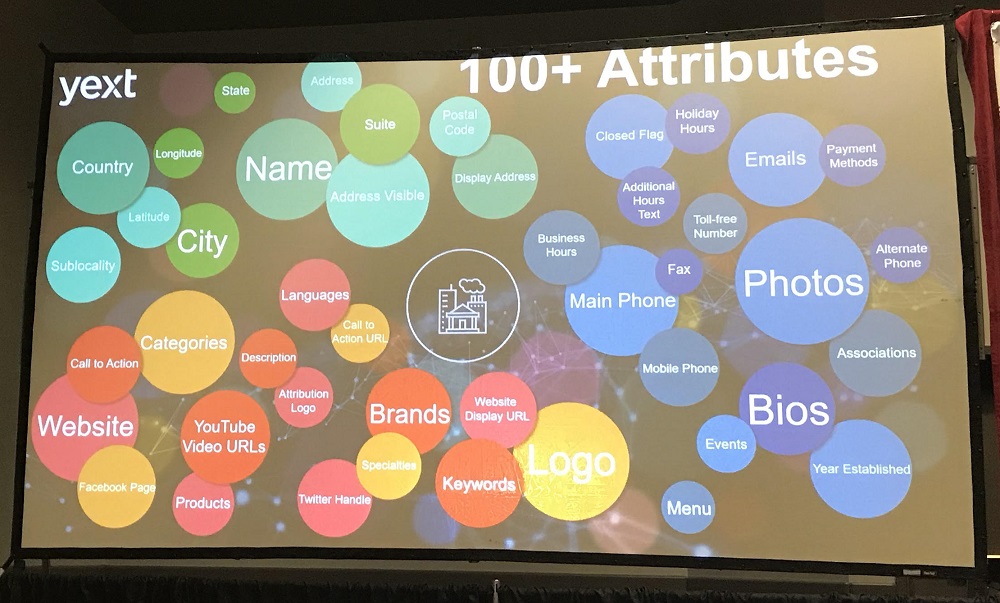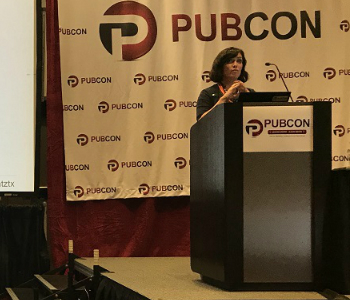In 2016, Google reported that 20% of the queries it gets today are voice searches. (Source: SearchEngineLand)
Around the same time, Mary Meeker shared a prediction that by 2020, 50% of searches will be voice or visually based. (Source: Recode)
If you’re not familiar with visual search (and I wasn’t in this context), it’s search and retrieval instigated by the searcher “showing” a device or product like the one they’d like to buy (or if not buy, then get more information about). Here’s an example: shop for dog food by showing your device the near-empty bag of dog food in your pantry, and then buy it from Amazon or another online retailer. Go ahead and look into the Amazon Echo Look for a visual-search-type device that’s almost to market.
If we as marketers understand that text-based search is trending-down-to-obsolete over the next two years, and that our customers will be searching with their voices and images, what do we do to evolve our marketing strategies?
Director of Account Strategy at Marketing Refresh, Katy Katz, and VP of Industry Insights at Yext, Duane Forrester, shared their plans of attack for exactly that with the rapt audience at Pubcon Las Vegas this week.
This post covers (jump to section with links):
Eye-Opening Stats and Findings about How Well Voice Search Serves Consumers
What are people trying to do with voice commands today? Katy shares the findings of SEER Interactive’s 2017 study about the kinds of actions people use voice search for:

Look at those top voice-activated actions! They’re pretty personal. Your customers expect personalization. They’re expecting you to know who they are and what’s important to them. They want you to personalize their experience.
Consumers ask questions in a personal way. Artificial intelligence (AI) is now smart enough to answer these questions. Katy’s 5-year-old used Alexa and said, “Alexa, play Darth Vader.” Smart Alexa played the Imperial March.
We can type 40 WPM, but we can speak 150–160 WPM! With voice search, people will articulate their queries more specifically and precisely.
In SEO and content marketing, voice search is making a big impact on strategy in these areas: keyword research, content strategy, and technical implementation. (That’s all. Just like, everything.)
Technical Considerations for SEOs and Content Marketers Optimizing for Voice Search
First, understand the anatomy of a voice query. These are the key features:
- The 5 Ws: Voice-triggered searches are usually looking for a result that answers a who, what, where, when, why or how question.
- Conversational: Voice searches are typically conversational (that is, use natural language).
- Long-tail: Voice searches are long-tail queries by their conversational nature.
- Mobile: Voice searches are done primarily on mobile devices.
- Clear intent: Voice searches are performed with a very clear and specific intent in mind.
Here’s an example voice search query where we can see how a digital marketer’s work to identify keywords, implement structured data markup, and gain positive reviews come into play when Google is determining result relevancy:

To establish a solid foundation for voice search SEO:
- Define your goals. You know the drill. Make sure they’re specific and measureable. Help you focus on what to focus on. She probably spends 80% of her time helping clients identify the goals that will give the highest ROI.
- ID your audience. Take the time to get to know your audience in audience interviews. You’ll learn about their pain points and goals and the questions they want to answer. There’s nothing else like talking to your customers.
- Achieve language-market fit. This term isn’t used a lot but it’s a big deal when it comes to search. It’s qualitative research into the exact words and phrasing that your buyers use to describe your product, service or category. Talk like your customers!

Katy Katz speaking at Pubcon Las Vegas
Map the buyer’s journey. Your customers are working through questions at each phase. If there are gaps in your content you’re missing out on opportunities.
With your foundation in place, optimize for these technical considerations for voice search:
Long-tail keywords. Here are keyword research tools for long-tail:
- Keyword.io
- Answer the Public
- Buzzsumo Question Analyzer
- SEMRush
- KWFinder
- Quora
- Google autocomplete
Snag those snippets. Design your content to optimize for featured snippets. Google Home and Siri are pulling quick answers for this. Short in nature. Simple, concise. Answers the questions in a way that provides utility for the user. The amount of snippets doubled this year. A snippetable post is short and digestible, fact-based logic; if Google already owns the Knowledge Graph, don’t even try to answer it.
Schema markup. Tell the search engines and AI what information is about. Making sure your house in order with different schema types is imperative for voice search.
Brand optimization. Manage your brand across the web. Off-site SEO and PR is everywhere. Local SEO, social media, off-site SEO, reviews are all influencing your consumers throughout their journey. It takes 6-8 touches for a prospect to convert to a sale. For local SEO, check out Moz Local, Yext, Reach Local, GMB. For reviews, check out Get Five Stars, Review Trackers, Yotpo, Reputation Loop — help you with automated tools to grow your reviews and show yourself as a trustworthy provider.
In sum, your buyers have questions each step of the way. There is no part of the journey that is more important than any other. Own the conversation. Own your brand.
User Behavior and New Technology That Is Shifting SEO

Duane Forrester speaking at Pubcon
The media we consume is shifting from the silver screen to our digital devices. With that, influence is shifting and celebrities are losing ground. Today, 6 in 10 YouTube subscribers would follow advice on what to buy from their favorite creator over their favorite TV or movie personality.
And there’s the consumer dependence and preference for their mobile device. Technology companies are investing across the board in assistants and AI. Duane asked the audience, “Who believes in the mobile-first Google index?” Well not only should you believe in it, Duane says that it is certainly live now and in use. He expressed that there’s one index and it’s filtered for mobile. He challenged marketers with the question, “Why would the search engine trust your site for the desktop user when you haven’t invested in the mobile user?”
Another area where user behavior is opening new avenues for marketing is local search. Location search is exploding. Note, however, that the growth in “near me” searches is flattening as it becomes assumed.
Want some more eye-opening stats? Duane shared these ones on local search and map behavior:
- 76% of people who use location search visit a business within one day.
- 28% of location searches result in a purchase.
- Digital maps reduce travel time by 12% on average.
- Digital maps save people more than 21 million hours per year.
- 63% of digital map users take advantage of them to plan safe routes.
- Digital maps have supported more than $1 trillion in sales for businesses.
- Geospatial services help companies raise revenue and diminish costs by more than 5%.
Hundreds of attributes contribute to local visibility:

Anyone hear about RankBrain lately? No one? That’s because it’s too busy out there learning.
Voice search is an important inflection point for us in the marketing community. Where we saw mobile coming, voice search is now here because all the tech that makes it possible developed independently.
There are 180 companies in China developing voice search speakers. Duane predicts that in a year, North America will be inundated with cheap, accurate voice search systems. The current players will carve out the higher end and the newer players will carve out the lower end that is able to perform nearly as completely.
Voice search is going to take off because people are lazy. Now we can just talk and get what we want. The next stage is visual search (image-based search) where the Alexa or Home device will show the searcher what they are trying to buy to confirm that’s what they are looking for.
Voice search tech is being embedded into home products like refrigerators and coffee makers. Your refrigerator will ping your phone when you’re at the store and tell you that you’re out of milk.
Tactics to Compete in Voice Search
Google’s not going to tell SEOs via Search Console which organic queries were performed with text search and which were voice search. Look into your site’s organic keyword data and find the queries that brought one visitor, maybe with the stop words removed, and then bundle those up and consider them your voice search terms.
Make sure your site is clean and accessible. Mobile-friendly matters and consumer behavior is happening on mobile devices. PWAs are the future – one code base for all UX and devices. Your developers are going to love having only one code base to manage, but it’ll be a few years for the technology to allow for this.
Secure your site, move to HTTPS. Check out the Wired.com articles where they detailed their move to secure. It was hard.
Today’s consumers want to attach to businesses that reflect their values. That doesn’t equate to donating to a cause, it’s more like getting your whole company to do a 5K in support of that cause and documenting the whole thing. Really invest in developing your brand in terms of its support of relevant and interested communities. Brand loyalty dropped a while ago and now businesses have to demonstrate their mission in their actions.
Skills Required of the Digital Marketer of the Future
This is your future: the digital knowledge manager. It’s a senior-level, cross-functional position. The digital knowledge manager requires a deep, varied career that has spanned many of the traditional core digital marketing competencies.
The digital knowledge manager needs to be able to speak the language of everyone. They will be adept at persuasion and convincing different groups to take on specific tasks. They are an investigator, negotiator, communicator, thinker, and builder.
As always in digital marketing, the future is now.

